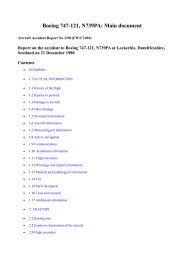REPORT OF THE - Archives - Syracuse University
REPORT OF THE - Archives - Syracuse University
REPORT OF THE - Archives - Syracuse University
You also want an ePaper? Increase the reach of your titles
YUMPU automatically turns print PDFs into web optimized ePapers that Google loves.
identified a "lack of clearly defined procedures" for the operations staff and noted that a<br />
single manager was providing training, supervisory and managerial functions.<br />
Overall, the inspector found that "the system, trying adequately to control approximately<br />
4,500 passengers and 28 flights per day, is being held together only by a very labor<br />
intensive operation and the tenuous threads of luck." Even so, the inspector concluded, "it<br />
appears the minimum [FAA] requirements can and are being met."<br />
At the end of the October inspection, the FAA agent specifically pointed out to Pan Am's<br />
Huebner the lack of a tracking system for interline bags and the confused state of the<br />
passenger screening procedures.<br />
Huebner was already well aware of the existence of problems like those surfaced by the<br />
October inspection. As he would testify to the Commission, Huebner had concerns that<br />
Alert personnel were "less well educated" and "not qualified" in all instances. Even<br />
before the October inspection, he had concluded that the number of Alert personnel was<br />
"inadequate" to guard Pan Am aircraft and that the passenger screening procedures were<br />
not working properly.<br />
On October 31, 1988, Huebner cabled the results of the October FAA inspection to<br />
Edward Cunningham, chief of security for all of Pan Am, concluding: "I have discussed<br />
these items in the past with [Pan Am] station management at Frankfurt. It has been<br />
pointed out to me that for financial reasons the security staff has to be kept to a<br />
minimum."<br />
The FAA did not cite Pan Am for any violation as a result of the October 1988<br />
inspection. The FAA did send Pan Am a letter October 28, requesting written evidence of<br />
the procedures that were in place for the passenger screening system. Pan Am's response<br />
was received at the FAA's regional office in Brussels on December 21, 1988.<br />
The Warnings<br />
In the period from June 1, 1988, to December 21, 1988, the FAA issued 14 security<br />
bulletins (with three followups), nine of which, in retrospect, could have been relevant to<br />
what became the Flight 103 tragedy. The carriers in Western Europe, and particularly in<br />
Frankfurt, should have been alerted by the cumulative FAA bulletins to the potential for<br />
trouble.<br />
Two of these nine bulletins warned generally of the possibility of Iranian retaliation for<br />
the downing of the Iranian civilian airbus over the Persian Gulf in July 1988. In the<br />
bulletins, the FAA commented that the retaliation might take the form of an attack on<br />
U.S. civil aviation.<br />
Two other bulletins gave warnings about particular Middle Eastern terrorists operating<br />
within Western Europe whose targets, the FAA commented, might include U.S. civil<br />
aviation interests. Another of the seven bulletins contained information about suitcase<br />
bombs in the possession of a Middle Eastern terrorist group that might be targeting<br />
Western interests in Europe, Africa or the Middle East.<br />
Two more bulletins passed on information about possible attempts to breach security at<br />
Western European airports. One described incidents during the summer of 1988 at<br />
Heathrow Airport in which an individual attempted to have other United States-bound<br />
passengers check in bags for him. The other described more general attempts to test and<br />
learn about security procedures at Frankfurt airport during the late November - early<br />
December 1988 period.










